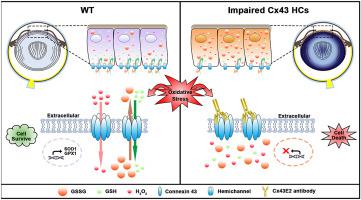Redox Biology ( IF 10.7 ) Pub Date : 2021-08-19 , DOI: 10.1016/j.redox.2021.102102 Yumeng Quan 1 , Yu Du 2 , Changrui Wu 2 , Sumin Gu 2 , Jean X Jiang 2

|
Increased oxidative stress contributes to cataract formation during aging. Anterior epithelial cells are a frontline antioxidant defense system with powerful capacities to maintain redox homeostasis and lens transparency. In this study, we report a new molecular mechanism of connexin (Cx) hemichannels (HCs) in lens epithelial cells to protect lens against oxidative stress. Our results showed haploinsufficiency of Cx43 elevated oxidative stress and susceptibility to cataracts in the mouse lens. Cx43 HCs opened in response to hydrogen peroxide (H2O2) or ultraviolet radiation (UVR) in human lens epithelium HLE-B3 cells, and this activation contributed to a cellular protective mechanism against oxidative stress-induced apoptotic cell death. Furthermore, we found that Cx43 HCs mediated the exchange of oxidants and antioxidants in lens epithelial cells undergoing oxidative stress. These transporting activities facilitated a reduction of intracellular reactive oxygen species (ROS) accumulation and maintained the intracellular glutathione (GSH) level through the exchange of redox metabolites and change of anti-oxidative gene expression. In addition, we show that Cx43 HCs can be regulated by the intracellular redox state and this regulation is mediated by residue Cys260 located at the Cx43 C-terminus. Together, our results demonstrate that Cx43 HCs activated by oxidative stress in the lens epithelial cells play a key role in maintaining redox homeostasis in lens under oxidative stress. Our findings contribute to advancing our understanding of oxidative stress induced lens disorders, such as age-related non-congenital cataracts.
中文翻译:

连接蛋白半通道通过代谢物交换调节氧化还原电位,并保护晶状体免受细胞氧化损伤
氧化应激增加会导致衰老过程中白内障的形成。前上皮细胞是前线抗氧化防御系统,具有维持氧化还原稳态和晶状体透明度的强大能力。在这项研究中,我们报告了晶状体上皮细胞中连接蛋白(Cx)半通道(HC)保护晶状体免受氧化应激的新分子机制。我们的结果表明,Cx43 的单倍体不足会增加小鼠晶状体中的氧化应激和白内障易感性。在人晶状体上皮 HLE-B3 细胞中,Cx43 HC 响应过氧化氢 (H 2 O 2 ) 或紫外线辐射 (UVR) 而打开,这种激活有助于形成针对氧化应激诱导的细胞凋亡的细胞保护机制。此外,我们发现 Cx43 HC 介导经历氧化应激的晶状体上皮细胞中氧化剂和抗氧化剂的交换。这些转运活动促进了细胞内活性氧(ROS)积累的减少,并通过氧化还原代谢物的交换和抗氧化基因表达的变化维持细胞内谷胱甘肽(GSH)水平。此外,我们还发现 Cx43 HC 可以通过细胞内氧化还原状态进行调节,并且这种调节是由位于 Cx43 C 末端的残基 Cys260 介导的。总之,我们的结果表明,晶状体上皮细胞中氧化应激激活的 Cx43 HC 在氧化应激下维持晶状体氧化还原稳态中发挥着关键作用。我们的研究结果有助于增进我们对氧化应激引起的晶状体疾病(例如与年龄相关的非先天性白内障)的理解。









































 京公网安备 11010802027423号
京公网安备 11010802027423号